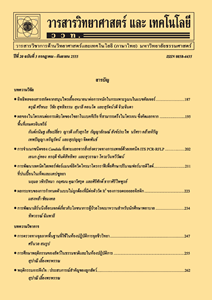การเพิ่มประสิทธิภาพของระบบบำบัดน้ำเสียแบบบ่อปรับเสถียรของมหาวิทยาลัยธรรมศาสตร์ ศูนย์รังสิต
Main Article Content
Abstract
บทคัดย่อ
ในระบบบำบัดน้ำเสียโดยทั่วไปที่ใช้บ่อปรับเสถียรเป็นบ่อบำบัดในขั้นตอนสุดท้ายเช่นเดียวกับระบบบำบัดน้ำเสียของมหาวิทยาลัยธรรมศาสตร์ ศูนย์รังสิต มักประสบปัญหาปริมาณสาหร่ายที่มีมากในบ่อบำบัดสุดท้าย ซึ่งถ้ามีการปล่อยลงสู่แหล่งรับน้ำจะก่อให้เกิดการเพิ่มของปริมาณสารอินทรีย์ บีโอดีและความขุ่นในแหล่งน้ำนั้น ดังนั้นจึงต้องมีการกำจัดสาหร่ายออกก่อนโดยทั่วไปมักใช้กรวดหยาบ กรวดละเอียด ถ้าเมื่อใช้ไประยะหนึ่งแล้วจะเกิดการอุดตันที่ยากต่อการล้างเพราะกรวดจะมีน้ำหนักมาก ในการวิจัยในครั้งนี้จึงได้ทำการศึกษาและเปรียบเทียบประสิทธิภาพการกำจัดสาหร่ายและความขุ่นของน้ำออกจากบ่อบำบัดโดยใช้ถังกรองแนวนอนแบบ 2 ขั้นตอน โดยขั้นตอนแรก ใช้ตัวกรองที่มีขายในท้องตลาด ส่วนขั้นตอนที่สองใช้กรวดละเอียดขนาด 2-6 มม. ตัวกรองพลาสติกที่ใช้มี 2 ขนาดคือ 240 ม2/ม3 (SBM) และ 105 ม2/ม3 (BBM) ตัวแปรที่ศึกษาได้แก่ ความเร็วการไหลหรืออัตราการกรอง จากการทดลองพบว่าที่ความเร็วการไหล 0.3 ม./ชม. SBM มีประสิทธิภาพในการกำจัดสาหร่ายได้ดีกว่า BBM ซึ่งเฉลี่ยเป็นร้อยละ 89 และ 84 ตามลำดับ และกำจัดความขุ่นได้ร้อยละ 64 และ 58 ตามลำดับ และเมื่อนำมาต่ออนุกรมเข้ากับถังกรวดละเอียด (ขั้นตอนที่สอง) พบว่าการกำจัดสาหร่ายมีประสิทธิภาพร้อยละ 91 และ 86 การกำจัดความขุ่นเฉลี่ยเป็นร้อยละ 66 และ 62 ใน SBM และ BBM ตามลำดับ และเมื่อเพิ่มความเร็วการไหลจาก 0.3 ม./ชม. เป็น 1.0 ม./ชม. ใน SBM โดยมีปริมาณสาหร่ายในน้ำเข้า (Influent) อยู่ในช่วง 35 ถึง 143 ไมโครกรัม/ลิตร พบว่าประสิทธิภาพในการกำจัดสาหร่ายและความขุ่นเฉลี่ยลดลงเป็นร้อยละ 59 และ 63 ตามลำดับ ประสิทธิภาพรวมของสองขั้นตอนสามารถกำจัดสาหร่ายและความขุ่นเป็นร้อยละ 65 และ 70 ตามลำดับ และเมื่อเพิ่มความเร็วการไหลจาก 0.3 ม./ชม. เป็น 2.0 ม./ชม. โดยมีปริมาณสาหร่ายในน้ำเข้าอยู่ในช่วง 30 ถึง 327 ไมโครกรัม/ลิตร พบว่า SBM มีประสิทธิภาพในการกำจัดสาหร่ายและความขุ่นเฉลี่ยเป็น ร้อยละ 41 และ 64 ตามลำดับ ประสิทธิภาพรวมของสองขั้นตอนสามารถกำจัดสาหร่ายและความขุ่นเป็นร้อยละ 50 และ 70 ตามลำดับ และเมื่อมีการลดความเร็วการไหลเป็น 0.3 ม./ชม. ประมาณ 3 วัน แล้วเพิ่มความเร็วไปเป็น 2.0 ม./ชม ตามเดิมพบว่าประสิทธิภาพโดยรวมของการกำจัดสาหร่ายและความขุ่นมีค่าเพิ่มขึ้น ส่วนปริมาณออกซิเจนละลายน้ำเฉลี่ยในน้ำออก (Effluent) ทุกความเร็วการไหลมีค่าสูงกว่า 2 มก./ล. และประสิทธิภาพในการกำจัดค่าซีโอดีโดยเฉลี่ยของทุกความเร็วการไหลมีค่าประมาณร้อยละ 50 ในชุดการทดลองสุดท้ายมีการเพิ่มความเร็วจาก 0.3 ม./ชม. เป็น 3.0 ม./ชม. และมีการเพิ่มปริมาณความขุ่นในน้ำเข้าสูงเกือบถึง 1000 NTU ในลักษณะเป็นพักๆ พบว่าประสิทธิภาพรวมของสองขั้นตอนสามารถกำจัดปริมาณสาหร่ายได้ร้อยละ 20 โดยมีปริมาณสาหร่ายในน้ำออกเฉลี่ย 67 mg/l และกำจัดความขุ่นเฉลี่ยได้เป็นร้อยละ 81 โดยปริมาณความขุ่นที่ออกมามีค่าเท่ากับ 23 NTU โดยเฉลี่ย ซึ่งจากการทดลองในชุดการทดลองสุดท้ายนี้สามารถนำไปออกแบบเพื่อทำการปรับปรุงคุณภาพน้ำของระบบบำบัดน้ำเสียมหาวิทยาลัยธรรมศาสตร์ ศูนย์รังสิตได้
คำสำคัญ : สาหร่าย; ถังกรองแนวนอน; ตัวกรองพลาสติก; ความเร็วการไหล; ความขุ่น
Abstract
Using oxidation ponds for polishing the effluent from the secondary treatment as well as the wastewater treatment plant of Thammasat University Rangsit Campus usually encounters the problems of high algae contents which results in the increase of organic and turbidity in the receiving water. Algae removal is normally done by using small and coarse gravel as filter media. However, it is very difficult to clean those gravels when the sediments and algae blocked the whole length of filter media at the end of the run. In this research, the performance of the two-stage horizontal-flow roughing filtration (HRF) was studied in order to remove the algae and reduce the turbidity. In the first-stage, two types of commercial plastic media, that were 240 m2/m3 (SBM) and 105 m2/m3 (BBM) and in second-stage, small gravel size 2-6 mm, were applied. The variable factor in this study was flow velocity. The results showed that under flow velocity of 0.3 m/h, the average algae removal efficiency of 89 percent from SBM was better than that of 84 percent from BBM. The turbidity removal efficiencies were 64 and 58 percent, in SBM and BBM, respectively. The algae removal efficiencies increased to 91 and 86 percent and turbidity removal efficiencies increased to 66 and 62 percent, when passed through secondary stage of small gravel filter for SBM and BBM, respectively. The results also showed that after the flow increased from 0.3 m/h to 1.0 m/h in SBM, the average algae and turbidity removal efficiencies reduced to 59 and 63 percent, respectively when influent algae were in the range of 35 to 143 mg/l. The overall average efficiencies of algae and turbidity removal in two-stage HRF were 65 and 70 percent, respectively. In addition the results also showed that after the flow increased from 0.3 m/h to 2.0 m/h the average algae and turbidity removal efficiencies reduced to 41 and 64 percent, respectively when influent algae were in the range of 30 to 327 mg/l. The overall average efficiencies of algae and turbidity removal in two-stage HRF were 50 and 70 percent, respectively. During this run, the flow was reduced from 2.0 m/h to 0.3 m/h for about 3 days after that the flow was increased to 2.0 m/h. It was found that the overall efficiency of the two-stage HRF for removal algae and turbidity was increased. The dissolved oxygen (DO) in the effluent of every run was over 2 mg/l and COD efficiency was average to 30 percent in each run. In the last run, after the flow increased from 0.3 m/h to 3.0 m/h and turbidity in water was increased up to ~1000 NTU by adding china clay intermittently. It was found that the overall efficiency of the two-stage HRF for algae removal was 20 percent. The algae content of the effluent was 67 mg/l. Furthermore, the turbidity removal was 81 percent on average. The turbidity content of the effluent was 23 NTU on average. This model is reasonable for design of full scale HRF for improving the pond effluent from the wastewater treatment plant of Thammasat University, Rangsit Campus and is easy to apply.
Keywords: algae; 2-stage; horizontal; flow; roughing; filter; plastic; media; flow; velocity; BBM/SBM


